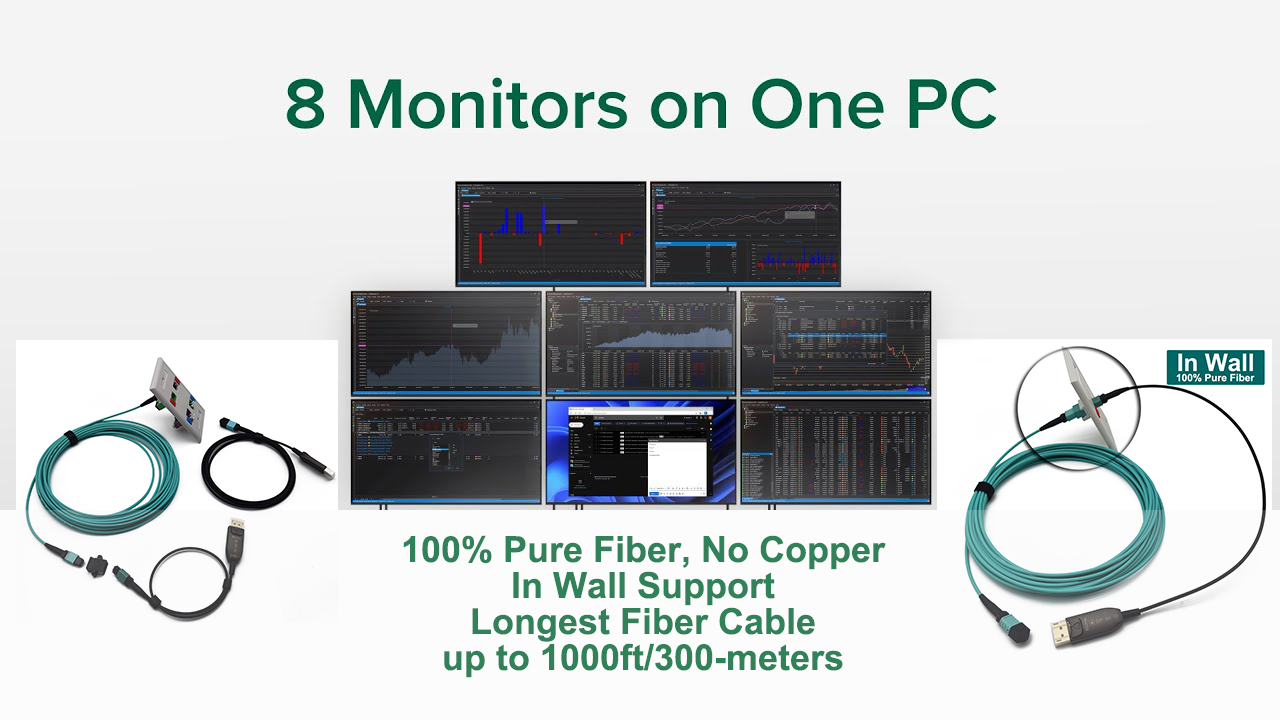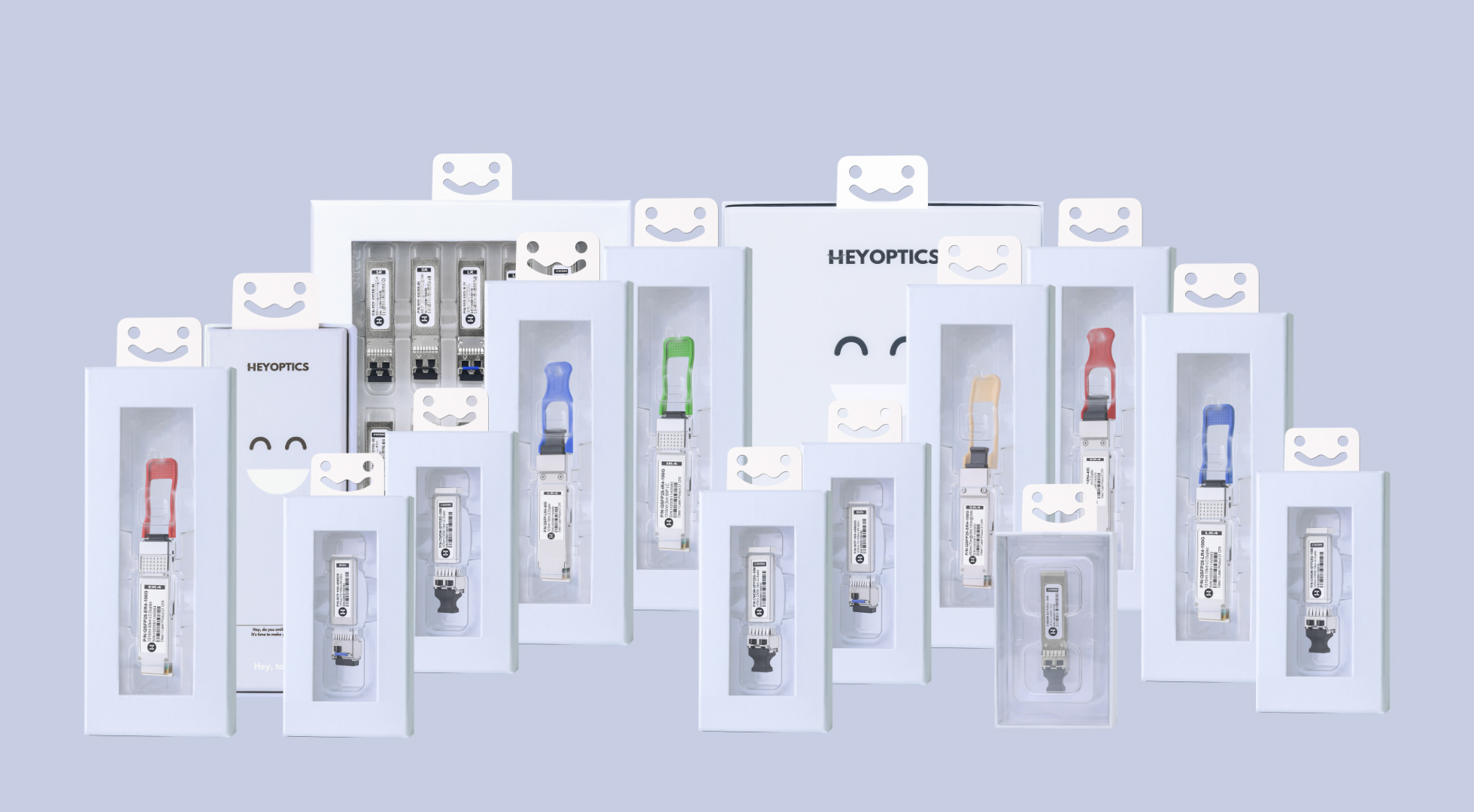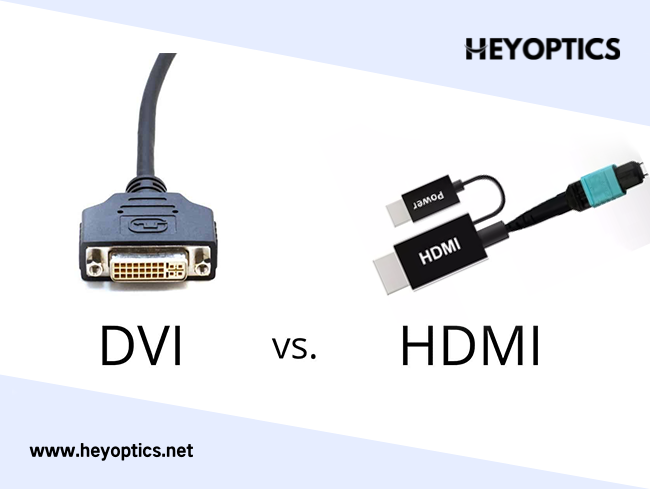What is the difference between 200G QSFP56 and 200G QSFP-DD?
QSFP56 and QSFP-DD are form factors that describe transceivers that meet specific engineering requirements. QSFP56, or quad small form factor 56, came out in 2017 and by its very nature represented a step forward in design over earlier QSFP modules. QSFP-DD (quad small form factor double-density), was in development at the time, has since been refined and is now on the market. Its elegant intricate engineering architecture ultimately affords customers the option of future upgrades for their networks by accommodating higher speeds and bandwidths to process more data faster. In this article, you will have a more intuitive understanding of QSFP56 and QSFP-DD.
What is the 200G optical transceiver?
1)QSFP56
The QSFP56 module has four transmit and receive channels, each capable of 53.125 Gb/s operation which together yield an aggregate data rate of 200Gb/s. It utilizes 850nm,
1310nm, CWDM or LWDM wavelengths to transmit data. QSFP56 uses optical MPO or LC connectors for the optical interface and a 38-pin connector for the electrical interface. Unlike previous QSFP form factors, it leverages PAM4 digital modulation scheme.
The QSFP56 was engineered to support 200G Ethernet.
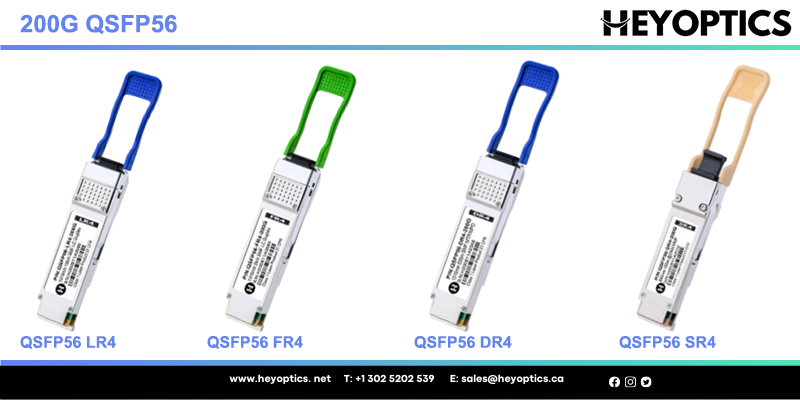
2)QSFP-DD
The QSFP-DD (quad small form factor pluggable double-density) optical transceiver is compliant with IEEE802.3bs and QSFP-DD MSA standards.
The double-density construction essentially multiplies lanes of electrical interface. While the QSFP28 transmits four lanes of 25Gb/s to achieve a total data rate of 100Gb/s, the 200G QSFP-28 DD (or the 200G QSFP-DD as it’s widely known) is designed with an eight-lane electrical interface and supports a 212.5Gb/s aggregate bit rate in total. The optical interface is either an MPO or duplex LC connector.
QSFP-DD is backwards compatible with most QSFP form factors including QSFP 56.
QSFP-DD electrical interfaces employ eight lanes that each operate on up to 25 Gbps NRZ modulation or 50 Gbps PAM4 modulation, providing solutions up to 200 Gbps or 400 Gbps respectively.
How to choose:200G QSFP56 vs. QSFP-DD
With the exponential growth of network traffic, various application scenarios such as data center interconnection, metropolitan area network, and long-distance network have put forward new requirements for the capacity, density, and complexity of optical transmission platforms. In order to meet the needs of users, the transmission rate of optical communication has also increased, from the previous 10G, 25G, 40G to today's 100G, 200G and so on. Although 100G optical modules have become mainstream in the market, the requirements for bandwidth, port density and energy consumption by the system are still increasing, which further promotes the development of this technology to 200G systems.
QSFP56 vs QSFP-DD: Comparative Advantages and Disadvantages
- QSFP56 was designed to support 200G applications and cannot accommodate an upgrade of networks to 400G and beyond;
- QSFP-DD runs in both 200G and 400G versions and allows incremental network upgrades;
- QSFP56 uses PAM4 modulation. QSFP-DD typically runs on NRZ for 200G speeds;
- QSFP56 modules with PAM4 modulation require only the use of four lanes for 200G transmission, in contrast to eight lanes for QSFP-DD which saves fiber cost and reduces link loss;
- 200G QSFP-DD modules that run on NRZ modulation are not as fast but have other advantages: they have lower maintenance costs, consume less energy, have less latency, better BER ( Pre-FEC = E-8, post FEC = E-12) and are easy to deploy.
- QSFP-DD offers greater flexibility for network and systems engineers for upgrading networks; One of the upgrade options is a breakout application where higher speed QSFP-DD can be broken out to lower speed legacy form factors.
- QSFP-DD is backwards compatible with earlier iterations of QSFP modules, including QSFP56;
- QSFP56 is backwards compatible with QSFP-28 iterations but not with QSFP-DD;
- QSFP-DD transceivers are, generally speaking, more expensive but rising market demand may drive prices down.
200G QSFP-DD Advantages
200G (8x25G NRZ) QSFP-DD has the advantages of low power consumption, low latency, and easy deployment.
Low power consumption : The signal-to-noise ratio of NRZ is 9.54dB higher than that of PAM4. Compared with the transceiver of NRZ, a transceiver that implements PAM4 requires more advanced equalization function, so the modulation of PAM4 will be more complicated and the power consumption will be higher. NRZ power consumption will be lower, which is beneficial for optimizing the OPEX and cooling efficiency of the data center.
Low latency : PAM4 is more sensitive to noise and easier to be affected by noise. Under the same transmission conditions, the receiving bit error rate is higher, so it is necessary to add the FEC forward error correction mechanism, which will increase the transmission delay, and use NRZ The BER of 1E-15 can be achieved with FEC turned off, and the delay is lower. It has excellent performance in some special application scenarios with strict requirements on delay, such as "high-frequency trading" network scenarios.
Easy to deploy : For backward compatibility, when using PAM4, while retaining the existing NRZ circuits and logic, PAM4 must be implemented at every level from the PHY to the physical layer, and the 25G NRZ optoelectronic chip and optical device technology industry chain is mature. The development of related 200G port switches and 200G optical modules is relatively easy, and commercial deployment can be quickly realized.
Based on the above advantages, 200G QSFP-DD optical modules can realize low-cost optical interconnection within the data center. The common ones are 200G QSFP-DD SR8, PSM8, and LR8.
NRZ vs. PAM4
There are two technical directions for 200G optical modules, one is economical 8x25G NRZ modulation using QSFP-DD package; the other is 4x50G (up to 4x56G) PAM4 modulation using QSFP56 package.
NRZ and PAM4 are two different types of digital modulation techniques. NRZ stands for non return to zero.
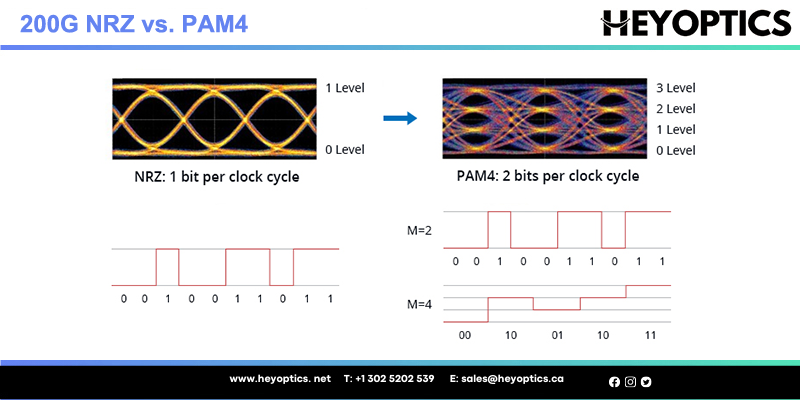
A modulation technique with two voltage levels representing logic 0 and logic 1, PAM4, or pulse-amplitude modulation, uses four voltage levels to represent four combinations of two bits logic-11, 10, 01, and 00.
A PAM4 signal can transmit twice as fast as the traditional NRZ signal.
Comparatively speaking, PAM4’s main advantage over NRZ is faster transmittal speed. Although not as fast, NRZ (at 200G) offers other desirable features, including lower power consumption, lower latency and easy deployment. 200G NRZ can achieve low-cost optical interconnection within data centers.
Several types of 200G transceivers
200G QSFP-DD/QSFP56 transceiver types:
QSFP-DD modules can support 400Gbps, while QSFP56 can only reach 200Gbps, so the QSFP56 package form is more commonly used in 200G optical modules.The following table lists the 200G QSFP-DD/QSFP56 transceiver:
| FORM FACTOR | WAVELENGTH | DISTANCE | CONNECTOR |
| 200G QSFP56 SR4 | 850 nm | 100m | MPO-12 |
| 200G QSFP56 DR4 | 1310nm | 500m | MPO-12 |
| 200G QSFP56 FR4 | 1271-1331 nm | 2km | LC |
| 200G QSFP56 LR4 | 1296-1309 nm | 10km | LC |
| 200G QSFP-DD LR4 | 1295.56nm, 1300.05nm, 1304.58nm, 1309.14nm |
10km | LC |
| 200G QSFP-DD ER4 | 1295.56nm, 1300.05nm, 1304.58nm, 1309.15nm |
40km | LC |
200G QSFP-DD/QSFP56 DAC/AOC Type
200G AOC:
There are two kinds of 200G AOC, QSFP28-DD AOC and QSFP56 AOC, both with a wavelength of 850nm. The QSFP56 cable package has four transmit and receive ports, the transmission rate of each channel is up to 56Gbps, and the modulation mode is PAM4. The QSFP28-DD package has eight transmit and receive ports, the transmission rate of each channel is 28Gbps, and the modulation mode is NRZ. The 200G AOC is mainly used in 200G Ethernet with a transmission distance of 1-100m.
200G DAC:
Similar to the 200G AOC, the 200G DAC has two packages: QSFP-DD DAC and QSFP56 DAC, both with a wavelength of 850nm. Different from 200G AOC, the power consumption of DAC is very small and can even be ignored, but its farthest transmission distance is only 5m.
As data centers continue to expand in size, transmission rates continue to get larger, so costs are trending straight up. Compared to 200G AOC, 200G DAC is smaller in power consumption because the connector module on top of the high-speed cable has no expensive optical lasers and other electronic components, which costs less. In summary, in the ultra-short distance of 200G data center transmission, DAC with price and power consumption advantage has received more attention.
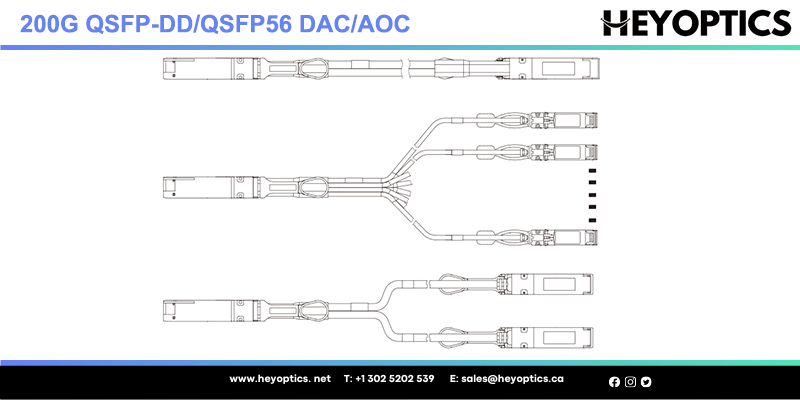
HeyOptics Advice
200G technology is more mature than 400G. Due to the competition between OEMs (original equipment manufacturers) and third-party module manufacturers, it also provides more choices for 200G optical modules, reducing their procurement costs. As a result, data centers with tight budgets can hold off on the more expensive 400G upgrade and go with the 200G intermediate solution first.
If the initial setup cost is considered, QSFP56 may be a better choice.
If cost is not an issue, you have compatible hardware and want the capability for future upgrades and more complex configurations, QSFP-DD offers more possibilities and may be a better choice.
Conclusion
Does your network equipment support upgrading to QSFP-DD? Not all switches and routers are configured to support QSFP-DD, so increasing link speeds may be impossible or very expensive. The standards and requirements of 200G and 400G are almost the same, but 400G optical transceivers are not widely used in the market. However, there are not many manufacturers that can provide 200G optical modules, and Heyoptics is one of the manufacturers that can provide it. If you don't have the right equipment, you run the risk of greater signal-to-noise ratios and more interference with data transmissions. If this is the case, QSFP56 may be a better choice. For data centers, upgrading from 100G to 200G is the best solution at this stage.
The cost of QSFP-DD transceivers ranges from 15% to 30% higher than QSFP56 transceivers. However, 200G QSFP-DD makes up for this initial cost with lower maintenance costs: it consumes less energy and electricity. Also, it achieves lower latency.
No matter which 200G transceiver you choose, it's a good choice. If you haven't upgraded to 200G, now is the time to do so.

